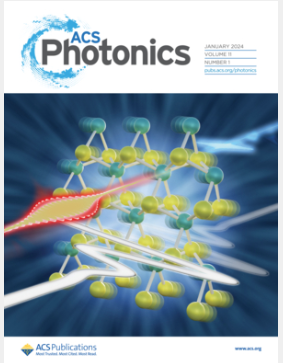采用纳米3D打印技术制造的超紧凑低串扰多芯光纤扇进/扇出器件
IF 6.5
1区 物理与天体物理
Q1 MATERIALS SCIENCE, MULTIDISCIPLINARY
引用次数: 0
摘要
多芯光纤作为一种高密度信道的光传输介质,在提高现代系统通信能力方面得到了越来越多的应用。MCF连接模块,也称为风扇输入/风扇输出(FIFO)设备,是这些应用中的关键组件。然而,当前一代的先进先出设备通常只有毫米大小,这给无缝集成多核光纤系统带来了挑战。在这项工作中,我们利用3D纳米打印技术设计并制造了一个7通道FIFO器件,其插入损耗为1.72 dB,芯间串扰小于- 61.21 dB,在C+L波段的平均插入损耗为2.23 dB。值得注意的是,利用高折射率对比度的3D打印光子结构特性和全内反射原理,我们实现了对光子传播方向的高效灵活控制,显著减小了器件的整体尺寸。整个FIFO器件的紧凑长度仅为140 μm。此外,基于所设计的波导还成功地实现了高阶模的传输。提出的紧凑型FIFO器件具有低损耗、低串扰和宽带功能,为3D光互连方案提供高密度集成解决方案。本文章由计算机程序翻译,如有差异,请以英文原文为准。

Ultracompact and Low Crosstalk Multicore Fiber Fan-in/out Device Fabricated via 3D Nanoprinting
As an optical transmission medium for high-density channels, a multicore fiber (MCF) is being increasingly utilized to enhance the communication capacity of modern systems. The MCF connecting module, also known as the fan-in/fan-out (FIFO) device, is a critical component in these applications. However, the current generation of FIFO devices, typically millimeter-sized, poses challenges for integrating multicore fiber systems seamlessly. In this work, we design and fabricate a 7-channel FIFO device using 3D nanoprinting, exhibiting an insertion loss of 1.72 dB and intercore crosstalk of less than −61.21 dB, with an average insertion loss of 2.23 dB in the C+L band. Remarkably, by utilizing the properties of a 3D printing photonic structure with a high refractive index contrast and the principle of total internal reflection, we achieve efficient and flexible control of the photon propagation direction, significantly reducing the overall size of the device. The total FIFO device has a compact length of just 140 μm. Additionally, the transmission of higher-order modes has also been successfully achieved based on the designed waveguide. The proposed compact FIFO device features low loss, low crosstalk, and broadband capabilities, offering a high-density integration solution for 3D optical interconnection schemes.
求助全文
通过发布文献求助,成功后即可免费获取论文全文。
去求助
来源期刊

ACS Photonics
NANOSCIENCE & NANOTECHNOLOGY-MATERIALS SCIENCE, MULTIDISCIPLINARY
CiteScore
11.90
自引率
5.70%
发文量
438
审稿时长
2.3 months
期刊介绍:
Published as soon as accepted and summarized in monthly issues, ACS Photonics will publish Research Articles, Letters, Perspectives, and Reviews, to encompass the full scope of published research in this field.
 求助内容:
求助内容: 应助结果提醒方式:
应助结果提醒方式:


